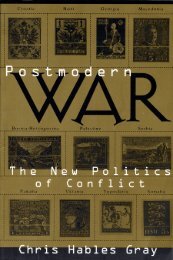Postmodern Wars Imaginary and Real: World War III - Chris Hables ...
Postmodern Wars Imaginary and Real: World War III - Chris Hables ...
Postmodern Wars Imaginary and Real: World War III - Chris Hables ...
Create successful ePaper yourself
Turn your PDF publications into a flip-book with our unique Google optimized e-Paper software.
[ 152 ] The Past<br />
Detailed histories of U.S. strategic doctrine show that many factors<br />
(ranging from political to technical) have helped shape it. Among the most<br />
significant was, <strong>and</strong> is, the use of scientific justifications such as SA <strong>and</strong> game<br />
theory. The careful hunt for "worst case" scenarios, combined with the<br />
inevitable bias toward measuring enemy capabilities (usually much exaggerated)<br />
instead of opponents' intentions, meant the extraordinary proliferation<br />
of nuclear weapons, nuclear platforms, <strong>and</strong> nuclear missions.<br />
In his book Think Tanks, Paul Dickson credits RAND with numerous<br />
innovations in these areas in its attempts to answer what RAND itself called<br />
"the unsolved problem of modern total war." He lists scenario writing, heuristic<br />
programing, computer modeling, linear programming, dynamic programming,<br />
problems scheduling, nonlinear programming, the Monte Carlo method, the<br />
Planning, Programing <strong>and</strong> Budgeting System (introduced in the DoD in 1960<br />
<strong>and</strong> the rest of the federal government in 1965), <strong>and</strong> SA itself (1971, pp.<br />
61-64). Most of these techniques were borrowed directly or metaphorically<br />
from computer science. What makes them particularly interesting—<strong>and</strong> postmodern—is<br />
that they are all ways of simulating (gaming, predicting, calculating)<br />
possible futures so as to justify constructing one in particular. Their<br />
effectiveness can only be judged by their results. They have supplied the<br />
rationale for the growth of the U.S. nuclear arsenal from 40 weapons to over<br />
25,000.<br />
Defense Secretary Robert S. McNamara admitted that U.S. nuclear<br />
policy has been "war-fighting with nuclear weapons" from the beginning<br />
(quoted in Herken, 1985, p. 306). The original Strategic Air Comm<strong>and</strong><br />
(SAC) plan of massive attack on the Soviet Union was soon attacked itself<br />
by the RAND consultants. Using systems analysis, Albert Wohlstetter<br />
claimed he had proven that the Soviets could "Pearl Harbor" the U.S.<br />
nuclear bombers. This threat <strong>and</strong> a parade of others usually labeled "gaps,"<br />
as in the bomber gap <strong>and</strong> the missile gap, have all been shown to have been<br />
nonexistent—after the election was won or the new weapons were built. But<br />
before being proven fallacious, they helped to create <strong>and</strong> elaborate the<br />
nuclear arsenal of the United States.<br />
Other think tank contributions to fighting nuclear war include RAND's<br />
development of the "distributed network concept" to make a communication<br />
system capable of continued operation during a nuclear attack <strong>and</strong> the<br />
development by a RAND spin-off, System Development Corp. (SDC), of<br />
the software for various air defense systems, including work on SAGE<br />
(Semi-Automatic Ground Environment) <strong>and</strong> BUIC (Back-Up Interceptor<br />
Control). One of the first of the 1,000 military jobs performed by SDC<br />
involved more than 500 programmers writing over a quarter of a million<br />
computer comm<strong>and</strong>s for the nation's air defense system, the biggest program<br />
of its time. SDC also designed the Navy's Space Surveillance System, <strong>and</strong> it<br />
has produced numerous nuclear war games for the Pentagon. The Pentagon's








